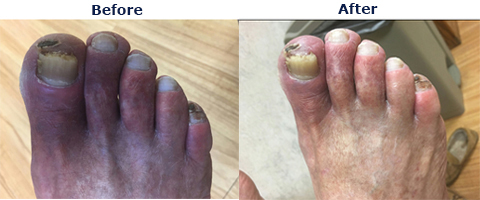Lower Extremity Arterial Limb Salvage Intervention at our Office Based Lab
Peripheral artery disease (PAD) causes narrowing of the peripheral arteries, most commonly in the arteries of the pelvis and legs. Commonly found in people with diabetes and smokers, PAD shares the same underlying causes as coronary artery disease, carotid artery disease and Erectile dysfunction . All cause reduced blood flow to organs supplied by the affected arteries.
When the arteries to the legs are affected exercise can increase the demand for blood flow beyond available supply resulting in a variety of painful symptoms and findings, including: Intermittent claudication (a term that refers to impairment in walking, or pain, discomfort or tiredness in the legs that occurs during walking and is relieved by rest).
Severe insufficiency can cause pain at rest.
- Leg numbness or weakness
- Coldness in the leg or foot
- Sores on the toes, feet or legs that heal poorly or don’t heal
- A change in color with redness when the legs are down and pallor when elevated
- Hair loss or slow hair growth on the feet and legs
- Slower toenail growth or thickened, deformed toenails
- No pulse or a weak pulse in the legs or feet
- Erectile dysfunction in men
All too often the symptoms of PAD progress to a point where a patient is told his or her only option is amputation. But as endovascular specialist we make great strides to ensure amputation is only a treatment of last resort, not a first option.
We collaborate with podiatrists, Wound care clinics, Infectious disease specialist and surgeons to improve wound healing. Instead of facing a scalpel and the loss of a toe, foot or entire lower leg, Apex cardiology patients are treated using a catheter that is threaded through a vessel to the point of blockage. A tiny balloon at the tip of the catheter is inflated to clear the blockage and restore blood flow. A stent is sometimes used in place to keep the vessel open.
Rather than enduring amputation and that procedure’s dramatically life-altering, and often life-threatening consequences, patients can often achieve relief from their PAD symptoms generally without even needing an overnight hospital stay. Many are up and walking the same afternoon and back at work in just a few days.
The benefits of treating PAD with angioplasty go beyond just saving a limb ,the procedure can also be life saving. According to American Heart Association, some 25 percent of people with below-the-knee amputations are dead within a year, half within three years. Tragically, many of these amputations could be avoided.
Fewer than 25 percent of patients who have had a non-traumatic amputation have had an angiogram in advance and without this information it is difficult to be certain that amputation is the only available, or the best, treatment option.
An angiogram is an X-ray study that enables physicians to visualize blood vessels and blood flow and determine precisely where a blockage is located. In the absence of an angiogram, an initial amputation of a toe, for example, may not even relieve the patient’s, leading to the amputation of another toe, then possibly the entire foot, and then higher up the leg until wound healing can occur.”
Amputation is a permanent solution to a potentially temporary problem, and it is surprising how often it is avoidable.”
Fortunately in our community we have cultivated good relationships with our surgeons and they understand that any patient who is being considered for amputation for PAD should first have an angiogram. “Through this simple step we have been able to identify many patients whose limbs, and sometimes lives, we can save through a procedure that we perform many times daily at Apex cardiology .










